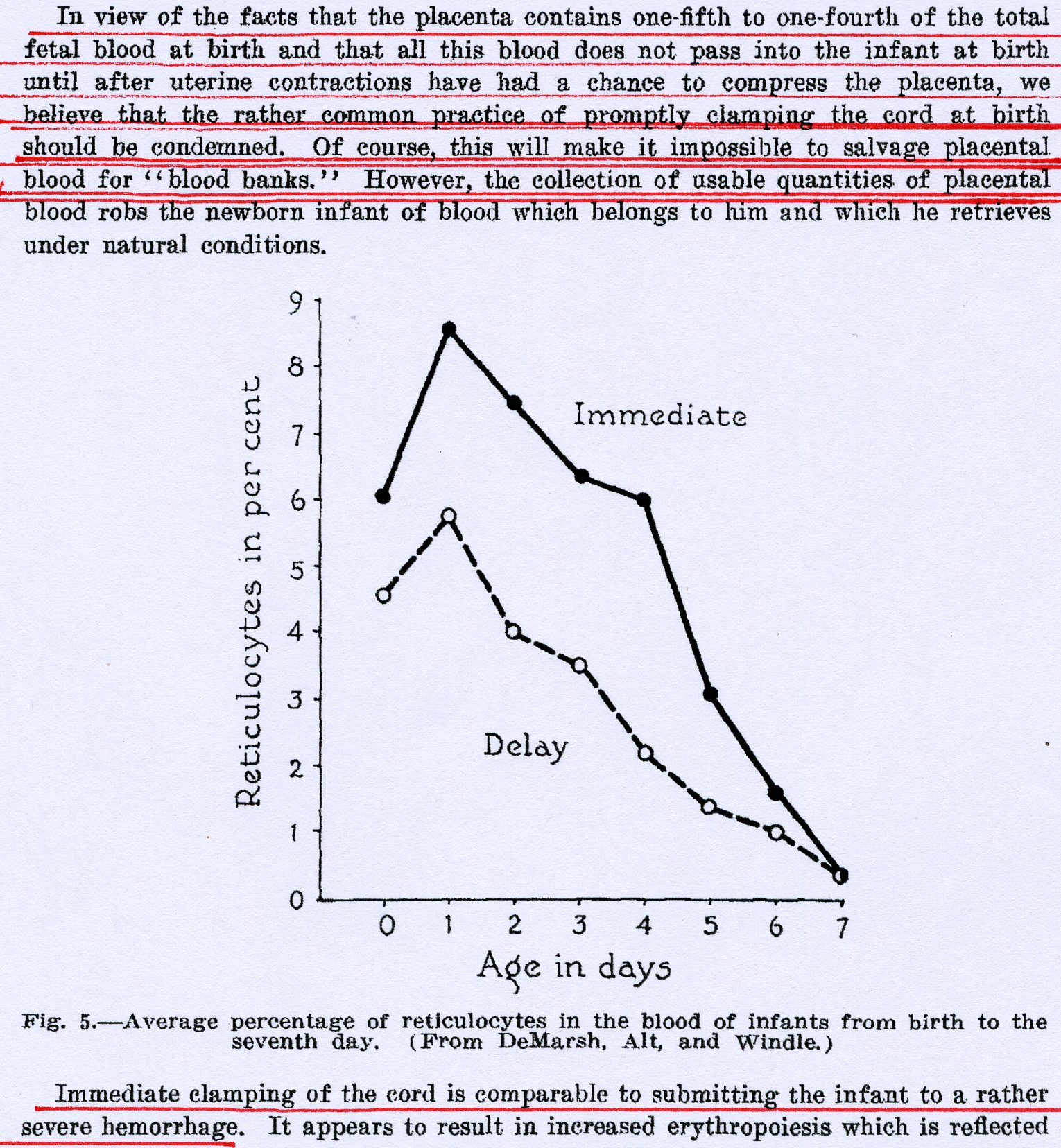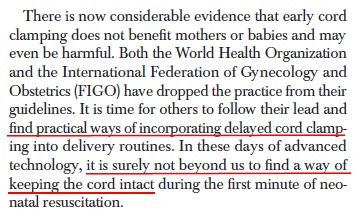On 24th October Fox News announced that Dr Michael Chez had begun an FDA approved trial of 30 children (using cord blood commercially stored by their parents) who were subsequently diagnosed with Autism. Dr Chez wants to see if the children’s own stem cells will reverse the autism, and has “high hopes” that the stem cells will do this.
The children have no genetic markers for autism and have developed it through an infection or an environmental factor (unspecified).
At no point does Dr Chez ask the question as to what babies are forfeiting, in exchange for the parents storing their cord blood. It’s of interest to me, that most news articles on the topic ALWAYS make the point of describing unbanked cord blood as “medical waste”.
Dr Chez, got the idea after treating boy A with Cerebral Palsy with stem cells his parents had stored, and the child responded very well. The problem is, that the immediate cord clamping required to harvest that blood reduces oxygenation to the brain, which as this Australian Professor states, increases the likelihood of Cerebral Palsy in the first place. The question needs to be asked, whether the parent's desire to harvest their baby's cord blood, created the brain condition, which caused the cerebral palsy.
Was this girl B's Cerebral Palsy which was reversed by cord blood cells, actually caused by the immediate cord clamping required in order to harvest that same cord blood --- that was later used to “cure” her?
Similarly, on March 29, 2011, Fox News reported the use of child C’s cord blood stem cells stored after her birth, being used to treat a tumour blocking the girl’s kidney.
Child C's mother, says, “I want to encourage other parents to save their child’s cord blood… I tell all our families and friends, it’s the cheapest life insurance you’ll ever buy and it’s an amazing opportunity for your children. To look at her, you’d never know, which is the best part of all.”
Come again?
Note that all the stories about children who are treated with their own cord blood stem cells, state that these cells are “medical waste” and the child doesn’t feel a thing, and that when infused into the body, these cells hunt out the injured spot and heal the problem.
The Fox News articles all make stem cell transplants look like a wonderful option. The comments about how it doesn’t hurt the baby are all the same, and all articles emphasize that the blood was sent to the bank of the parent’s choice.
There is an additional factor in child C's story, which will be mentioned shortly.
Looking at medical literature, let’s have a look at WHERE the baby gets its stem cells from in the first few years of life.
Right from conception a baby’s organ development is orchestrated by stem cells made in the placenta during pregnancy. Barcena 09 reports that the foetus is infused with those stem cells in utero.
The blood INSIDE the placenta grows the baby, is unique to that baby’s DNA, and belongs in the baby itself, after birth. It’s a pretty nifty arrangement which has several functions. If half of the baby’s blood remains in the placenta during vaginal descent, that decreases the volume of flesh which has to be conformed into and slide down a 10 cm wide pelvic canal, meaning that there is much less resistance, and the baby will come down easier. The baby still gets oxygen from the mother, but its muscles are much more “relaxed”. Far from placenta and cord blood being “medical waste”, just after the baby is born, when the baby’s chest expands, the lungs open out and try to fill with blood… when the cranial plates spring apart and the arms and legs wave around with the accompanying pins and needles, all that placental blood which belongs to the baby, is rushing back into the baby because of ongoing uterine contractions. That blood increases the blood volume in the baby by at least one third (Hutton 07).
One effect from this was illustrated in this article from 1940. Yes, you read that correct. 1940. They KNEW that immediate cord cutting was bad, even back then:

And yes, the medical profession has collected cord blood since 1941, though goodness knows what they did with it. While I would like to say that immediate cord clamping is not common in this country, that isn’t quite true. Unfortunately it is widely practiced in the bigger hospital and teaching hospitals. However, independent midwives, home-birth midwives and smaller country hospitals in general, seem to be much more amenable to not immediately clamping the cord.
But it would appear that in USA, and other countries where cord blood banking has become the expensive fashionable thing to do, mothers are convinced that cord blood is otherwise “medical waste”.
The massive influx of blood – which belongs to that baby - is vital to the baby and is described in this 2009 document I wrote, detailing the third stage of labour. And anyone who has read here before knows that I have no patience with medical people who immediately clamp cord as a matter of habit and protocol, or for cord blood storage.
So, how is this cord blood for transplantation collected, and how much blood is stored?
According to Hemastem, an American cord blood bank, IMMEDIATELY on birth, the cord is clamped. It looks like a purple pulsating sausage with very distended veins. A syringe is inserted into the largest of the three cords, which has the blood going into the baby. There is no need to pull a plunger or anything, because the cord has considerable pressure, which by itself, passively pumps all that blood into a container about the size of one cup, which has in it an anti-coagulant to stop the blood from clotting. The syringe is removed, the container sealed, and that costs the parent a sweet 2 – 3,000 dollars, plus an annual fee for storage. Hemastem says that between 60 and 150 mls is stored.
According to Cord Blood Donation.net, 180 mls of blood is stored. Furthermore, parents who can’t afford to pay to have blood stored for their own children, are “encouraged” to “donate” this MEDICAL WASTE so that someone else might benefit from it. Does the term “medical waste” start to take on a new dimension in your mind?
In 1967, the ideal blood volume in a baby was calculated at 85 mls per kg of body weight. Hutton 07 makes it clear that immediate cord cutting removes 20 – 40 mls per kg out of that optimum 85 mls per kg, of body weight. So if your baby weighs 4 kgs in weight, this lack of blood is the equivalent of a haemorrhage removing 80 to 160 mls from the possible total blood amount of 340 mls. This is like depriving an adult of a quarter to a half of their total body amount of blood. Does that sound like a good idea?
In 2009, Pikser stated that between 25 – 60% of the total feto-placental circulation is found in the placenta at term, and allowing placental transfusion into the baby results in a 30% increase in blood volume and a 60% increase in red blood cells.
In other words, those who consider this cord blood to be medical waste, deprive their baby of 60% of red blood cells which the baby should have after birth. Do those red blood cells sound like “waste” to you? And people pay big money to deprive their baby of its own blood.
What was the rationale for immediate cord clamping in the first place? In 2007, a medical article stated that there is, and never was, a scientific rational for immediate cord clamping. Here is a timeline from books down through the ages, talking about physiological optimum third stage labour. In this “scientific” age, immediately cutting the cord is not only utterly lacking in science and common sense, it works against the best interest of babies. Furthermore the timeline clearly shows that immediate cord cutting is a phenomenon which only became “common” as conventional obstetrics considered itself more "advanced". Which possibly means that cutting the cord was a billable item charged to the patient.
There are some obstetricians leading the charge to stop immediate cord clamping. One is Dr Hutchon http://www.hutchon.net/ who stated quite clearly in a medical journal in 2008 that immediate cord clamping must cease, and in 2010, that immediate cord clamping is not a physical necessity. You’d think, in an era rife with high malpractice insurance that leads many obstetricians leaving the profession, that practising delayed cord clamping would be seen as added insurance and security for the obstetrician.
The other obstetrician who is hopping mad about cord cutting is Professor G. M. Morley http://www.cordclamp.org/
Dr Morley’s website reads:
Birth Injuries Related to Umbilical Cord Clamping:
“Autism, cerebral palsy, anemia, hypovolemia, hypotension, ischemia, shock, shock lung, respiratory distress, oliguria, hypoglycemia, ischemic encephalopathy, mental retardation; neural, behavioral and developmental disorders.”
How much clearer can you get? Dr Morley believes that the brain damage created by immediate cord clamping can predispose a child to autism.Dr Morley considers Cerebral Palsy to be a direct result of the brain damage that can follow immediate cord clamping.
But in Child C's case, the story gets much worse.
By now, anyone reading this blog KNOWS that breastmilk is ALSO loaded with stem cells because God designs a baby to be a continuum of in utero growth, programming and development. Growth is so fast after birth, that it’s vital the baby continues to receive an ongoing supply of stem cells in breast milk in order to give children the best possible chance.
But breast milk is also loaded with a substance which, if a baby gets any form of cancer, can nuke the cancer, and then the stem cells go in afterwards and heal everything.
So, not only was child C deprived of her own stem cells by immediate cord clamping, her problems were compounded BECAUSE she was fed formula from birth. (Note the story doesn’t admit or discuss that, but when you know the medical literature, the actions of a key substance in breastmilk are obvious.)
In 1990, a doctor at Lund University called Catarina Svanborg, accidentally discovered that alpha- lactalbumin in human breast milk had both nutritive and non-nutritive properties. She found that when lactalbumin partially UN-folded itself and joined with oleic acid, it formed a substance which she called HAMLET, meaning Human Alpha-lactalbumin Made LEthal to Tumor cells. In short, breastmilk HAMLET is THE ultimate cancer destroyer which has no side effects.
Using a multipronged approach, HAMLET selectively rips apart walls of dysplastic cells, messes up the mitochondria, and using other immunological “cluster bombs”, blasts, detaches and rapidly pummels cancer to pieces and destroys it.
Much of Dr Svanborg’s work can be found here.
For as long as a mother breastfeeds, her child is drenched in abundant quantities of HAMLET, or alpha lactalbumin… which actively patrols, seeks out and destroys cancer in that baby.
Here is a geekspeak explanation for those who require it:
2009
Here we present HAMLET (Human Alpha-lactalbumin Made LEthal to Tumor cells) as an example where partial unfolding and the incorporation of a cofactor create a complex with new, beneficial properties. Native alpha-lactalbumin functions as a substrate specifier in lactose synthesis, but when partially unfolded, the protein binds oleic acid and forms the tumoricidal HAMLET complex.
2008
HAMLET has broad antitumor activity in vitro, and its therapeutic effect has been confirmed in vivo in a human glioblastoma rat xenograft model, in patients with skin papillomas and in patients with bladder cancer. The mechanisms of tumor cell death remain unclear, however. Immediately after the encounter with tumor cells, HAMLET invades the cells and causes mitochondrial membrane depolarization, cytochrome c release, phosphatidyl serine exposure, and a low caspase response. A fraction of the cells undergoes morphological changes characteristic of apoptosis, but caspase inhibition does not rescue the cells and Bcl-2 overexpression or altered p53 status does not influence the sensitivity of tumor cells to HAMLET. HAMLET also creates a state of unfolded protein overload and activates 20S proteasomes, which contributes to cell death. In parallel, HAMLET translocates to tumor cell nuclei, where high-affinity interactions with histones cause chromatin disruption, loss of transcription, and nuclear condensation. The dying cells also show morphological changes compatible with macroautophagy, and recent studies indicate that macroautophagy is involved in the cell death response to HAMLET. The results suggest that HAMLET, like a hydra with many heads, may interact with several crucial cellular organelles, thereby activating several forms of cell death, in parallel. This complexity might underlie the rapid death response of tumor cells and the broad antitumor activity of HAMLET.
You may now put away your medical dictionary.
So plainly put, if Child C's parents had NOT had her cord clamped, their baby would have received her full quotient of stem cells free of charge, which could have healed whatever the problem was, and HAD she been breastfed, then chances are, that she would not have developed a tumour, and wouldn’t have needed a stem cell transplant. Her parents could have saved themselves hundreds of thousands of dollars in hospital bills, and a truck load of worry as well.
A fetus is designed with placentally made, pluripotent (pluripotent = relating to all cells in the body) stem cells just waiting in the placenta and umbilical cord, to slide down into the baby - if the cord is left open and NOT clamped. As this medical article states, it's the baby's FIRST stem cell transplant. And a mother’s breastmilk provides cancer destroyers and stem cells.
The medical literature is absolutely FULL of medical articles expanding the topics in this short blog - - YET…. at the same time, the medical system regularly presents stories from people like Child C's parents, to try to persuade MORE parents to immediately clamp their baby’s cord in order to store the cord blood, which CAN LEAD TO exactly those problems these doctors are later using those children’s stem cells to fix!
The medical system does not tell people like Harlow’s mother that breastmilk is a continued source of both stem cells and cancer destroyers for as long as the baby is breastfed. They will probably tell the parents to try another formula. How about referring parents to a breast milk bank? Oh, that’s right. There isn’t one, because the medical system doesn’t think it’s worthwhile. I guess a breast milk bank is not worth supporting, if as a result, paediatricians earn less money while twiddling their thumbs in an empty office.
The current debate on cord cutting in the medical profession continues to be medieval and lackluster with the exception of a few such as Mercer 09 who stated,
“To prevent damage to newborns, the infant must receive the blood volume and stem cells lost at the time of descent and immediate cord clamping”.
My only quibble with this quote is the use of the word "lost". Some of the blood is temporarily diverted into the placenta in order to help the baby be born, and as soon as the baby is born, that blood is returned to the baby with the remainder in the cord, which fills the lungs. Watch this youtube video: http://www.youtube.com/watch?v=WWCOzkSe85M&feature=related I don't agree with his comments about extreme prematurity though... the more premature, the more important it is, to NOT cut the cord. This youtube presentation shows you how lay people can educate obstetricians in this case Dr Nicholas Fogelson: http://www.youtube.com/watch?v=cX-zD8jKne0&feature=related and part 2 http://www.youtube.com/watch?v=YDLywaBTd-o&feature=channel&list=UL and part 3 http://www.youtube.com/watch?v=SYhWzAjjRu8&feature=autoplay&list=ULYDLywaBTd-o&playnext=1 . He tells the story of how he got interested in delayed cord cutting and discusses some of what is here. Apart from these people, the clinical arguments amongst obstetricians, seem to centre more around HOW LONG they can wait before they get impatient and get out the clamp and scissors. An example is the conclusion of this article:

In the first minute the baby only gets 50% of the potential volume with the rest in the next 2 - 5 minutes. Well, here's a practical way to keep the cord intact.
Just LOSE the clamp and the scissors until the cord is hard, white and leathery.
The moral of this blog is simple.
The “voices” you listen to, .....will determine your choices, .....and the bed you lie in .... just might have unwelcome consequences.



